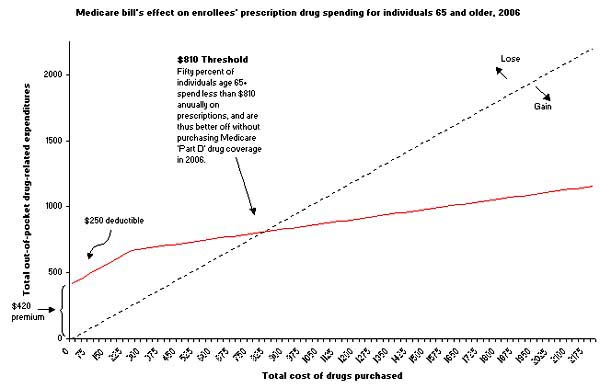Snapshot for November 26, 2003.
New plan fails half of elderly in 2006
The U.S. Congress passed a bill this week that (among other things) creates a new “Part D” of Medicare that would offer a prescription drug benefit for recipients. Despite it being touted as a boon to seniors, the new Medicare drug benefit is likely to help only half of the elderly population in 2006. An analysis of the bill shows that 50% of the over-65 population would face pharmaceutical expenses too low to reap any benefits from Part D in 2006, the first year of the new program.
Take, for instance, individuals who expect to need $700 in prescription drugs in 2006. If these people buy into the proposed drug benefit plan, they will first pay a total of $670 for the plan premium ($420) and the deductible ($250). For expenditures exceeding the deductible but below $2,250, the new Medicare Part D covers 75% of the costs. So in the current example, these enrollees would spend about $112.50 in co-payments for their $700 worth of medication. Ultimately, those in this scenario under Medicare Part D would shoulder a total cost of $782.50 ($112.50 co-pay plus $670 in premium and deductible), while those without the plan would have simply spent $700 on their drugs.
Essentially, anybody with less than $810 in expected annual drug costs will not reap any benefits under Part D, and this constitutes half of the over-65 population. *The chart below shows total drug costs and out-of-pocket drug expenditures under the new Medicare program. Those above the dotted line lose from buying the insurance because the cost of the premium, deductible, and co-insurance payment would exceed the cost of their drugs in 2006.

*Calculations based on 2000 Medical Expenditure Panel Survey drug expenditures inflated to 2006 using the estimated rise in the consumer price index for prescription drugs and medical supplies. This does not include poor persons whose drug expenses are more heavily subsidized.
This week’s Snapshot was written by EPI Economists Josh Bivens and Elise Gould.
Check out the archive for past Economic Snapshots.
